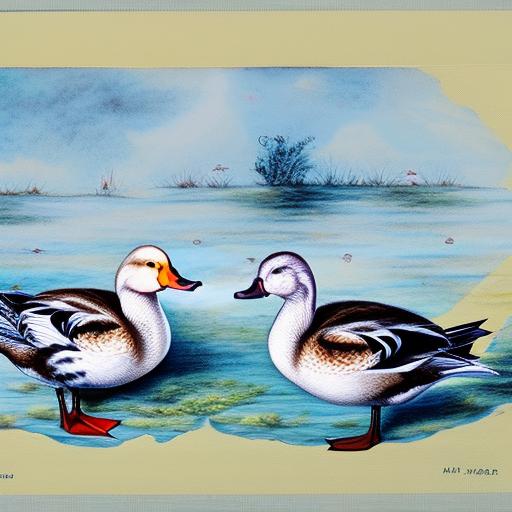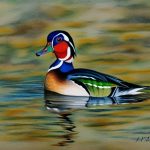Ducks are a diverse group of waterfowl that come in a wide variety of breeds, each with its own unique characteristics and traits. Some of the most popular duck breeds include the Pekin, Mallard, Rouen, Khaki Campbell, and Muscovy. Each breed has its own distinct physical appearance, temperament, and egg-laying capabilities. For example, the Pekin duck is known for its large size and white feathers, while the Khaki Campbell is prized for its high egg production. Understanding the differences between duck breeds is essential for breeders looking to produce specific traits in their flocks.
In addition to physical characteristics, different duck breeds also have varying reproductive behaviors and requirements. Some breeds may be more prone to broodiness, while others may require specific environmental conditions for successful breeding. It is important for breeders to familiarize themselves with the unique traits of each breed in order to effectively manage their breeding programs and ensure the health and productivity of their flocks.
Key Takeaways
- There are many different duck breeds, each with unique characteristics and traits.
- Reproductive compatibility between different duck breeds can vary, affecting breeding success.
- Factors such as age, health, and environment can impact the success of duck breeding.
- Hybrid duck offspring can exhibit a combination of traits from both parent breeds.
- Genetic diversity is important in duck breeding to maintain healthy and resilient populations.
Reproductive Compatibility of Different Duck Breeds
When it comes to breeding ducks, it is important to consider the reproductive compatibility of different breeds. While ducks are generally known for their ability to interbreed more easily than other poultry species, there are still factors to consider when crossing different breeds. Some breeds may have different mating behaviors or reproductive cycles, which can impact the success of breeding efforts. Additionally, certain breed combinations may result in offspring with undesirable traits or health issues.
For example, breeding a Pekin duck with a Muscovy duck may result in hybrid offspring that exhibit a mix of traits from both parent breeds. While this can sometimes lead to desirable characteristics, such as improved meat or egg production, it can also result in genetic abnormalities or reduced fertility. Breeders must carefully consider the genetic compatibility of different duck breeds in order to produce healthy and viable offspring.
Factors Affecting Breeding Success
Several factors can impact the success of breeding efforts in ducks. Environmental conditions, such as temperature and lighting, can play a significant role in stimulating reproductive behaviors and egg production. Additionally, the availability of nesting sites and the presence of predators can influence the likelihood of successful breeding. It is important for breeders to create a suitable environment for their ducks that encourages natural mating behaviors and provides adequate protection for nesting females.
Nutrition also plays a critical role in breeding success. Ducks require a balanced diet that provides essential nutrients for reproductive health and egg production. Inadequate nutrition can lead to poor fertility, low egg hatchability, and reduced overall breeding success. Breeders should ensure that their ducks are receiving a diet that meets their specific nutritional needs, especially during the breeding season.
Hybrid Duck Offspring
When different duck breeds are crossed, the resulting offspring are known as hybrids. Hybrid ducks can exhibit a wide range of traits, depending on the specific breeds involved in the cross. In some cases, hybrid offspring may display improved growth rates, meat quality, or egg production compared to purebred ducks. This can make hybrid breeding an attractive option for producers looking to maximize the productivity of their flocks.
However, it is important to note that not all hybrid offspring will exhibit desirable traits. Some hybrids may inherit genetic abnormalities or health issues from their parent breeds, which can impact their overall viability and productivity. Additionally, hybrid ducks may not breed true in subsequent generations, making it more challenging for breeders to predict and control the traits of their flocks. Breeders should carefully consider the potential benefits and drawbacks of hybrid breeding before incorporating it into their breeding programs.
Importance of Genetic Diversity in Duck Breeding
Maintaining genetic diversity is crucial for the long-term health and sustainability of duck breeds. Genetic diversity helps to ensure that ducks have the ability to adapt to changing environmental conditions and resist diseases. It also provides breeders with a wider range of traits to select from when breeding for specific characteristics such as egg production, meat quality, or temperament.
Inbreeding, or the mating of closely related individuals, can lead to a loss of genetic diversity and an increase in genetic disorders within a population. To prevent these issues, breeders should carefully manage their breeding programs to avoid excessive inbreeding and promote genetic variation within their flocks. This can be achieved through the introduction of new genetic lines or the use of outcrossing to bring in genetic material from unrelated individuals.
Breeding Strategies for Different Duck Breeds

Different duck breeds may require unique breeding strategies to maximize their productivity and health. For example, some breeds may be more prone to broodiness and require minimal intervention from breeders to successfully hatch and raise their offspring. Other breeds may benefit from artificial insemination or controlled mating to ensure genetic diversity and improve breeding outcomes.
Breeders should also consider the specific traits they are looking to promote within their flocks when developing breeding strategies. For example, if a breeder is focused on improving egg production, they may need to select for traits such as early sexual maturity and high egg-laying capacity. On the other hand, breeders aiming to produce high-quality meat ducks may prioritize traits such as rapid growth rates and efficient feed conversion.
In addition to selecting for specific traits, breeders should also prioritize the health and welfare of their ducks when developing breeding strategies. This includes providing adequate housing, nutrition, and veterinary care to ensure that ducks are able to express their natural behaviors and remain free from disease and injury.
Conclusion and Recommendations for Duck Breeders
In conclusion, understanding the unique characteristics and reproductive behaviors of different duck breeds is essential for successful breeding programs. Breeders should carefully consider the genetic compatibility of different breeds when crossing them to produce hybrid offspring, as well as prioritize genetic diversity within their flocks to maintain long-term health and productivity.
To maximize breeding success, breeders should create suitable environmental conditions for their ducks, provide a balanced diet that meets their nutritional needs, and develop tailored breeding strategies that align with their specific breeding goals. By prioritizing the health and welfare of their ducks and promoting genetic diversity within their flocks, breeders can contribute to the long-term sustainability of duck breeds and ensure the continued availability of diverse and productive duck populations for future generations.
If you’re curious about the mating habits of different breeds of ducks, you might find it interesting to read an article on Poultry Wizard that discusses the intricacies of breeding geese and caring for goslings. This informative piece provides valuable insights into the breeding process and offers practical tips for ensuring the well-being of your feathered friends. Check out the article here to learn more about raising and nurturing goslings, as well as other poultry-related topics.
FAQs
Can different breeds of ducks mate?
Yes, different breeds of ducks can mate with each other. However, there may be some challenges in terms of size differences and compatibility.
Are there any limitations to different breeds of ducks mating?
While different breeds of ducks can mate, there may be limitations in terms of successful reproduction and offspring viability. Some breed combinations may result in infertile eggs or offspring with health issues.
What are some factors to consider when breeding different duck breeds?
When breeding different duck breeds, it’s important to consider the size and compatibility of the breeds. Additionally, breeders should be aware of potential genetic issues that may arise from crossbreeding.
Can crossbred ducks be used for commercial purposes?
Crossbred ducks can be used for commercial purposes, but breeders should carefully consider the traits and characteristics of the crossbred offspring to ensure they meet the desired standards for commercial use.
Are there any specific precautions to take when breeding different duck breeds?
Breeders should be cautious when breeding different duck breeds to avoid potential genetic issues and to ensure the health and well-being of the offspring. It’s important to research and understand the potential outcomes of crossbreeding before proceeding.
Meet Walter, the feathered-friend fanatic of Florida! Nestled in the sunshine state, Walter struts through life with his feathered companions, clucking his way to happiness. With a coop that’s fancier than a five-star hotel, he’s the Don Juan of the chicken world. When he’s not teaching his hens to do the cha-cha, you’ll find him in a heated debate with his prized rooster, Sir Clucks-a-Lot. Walter’s poultry passion is no yolk; he’s the sunny-side-up guy you never knew you needed in your flock of friends!







